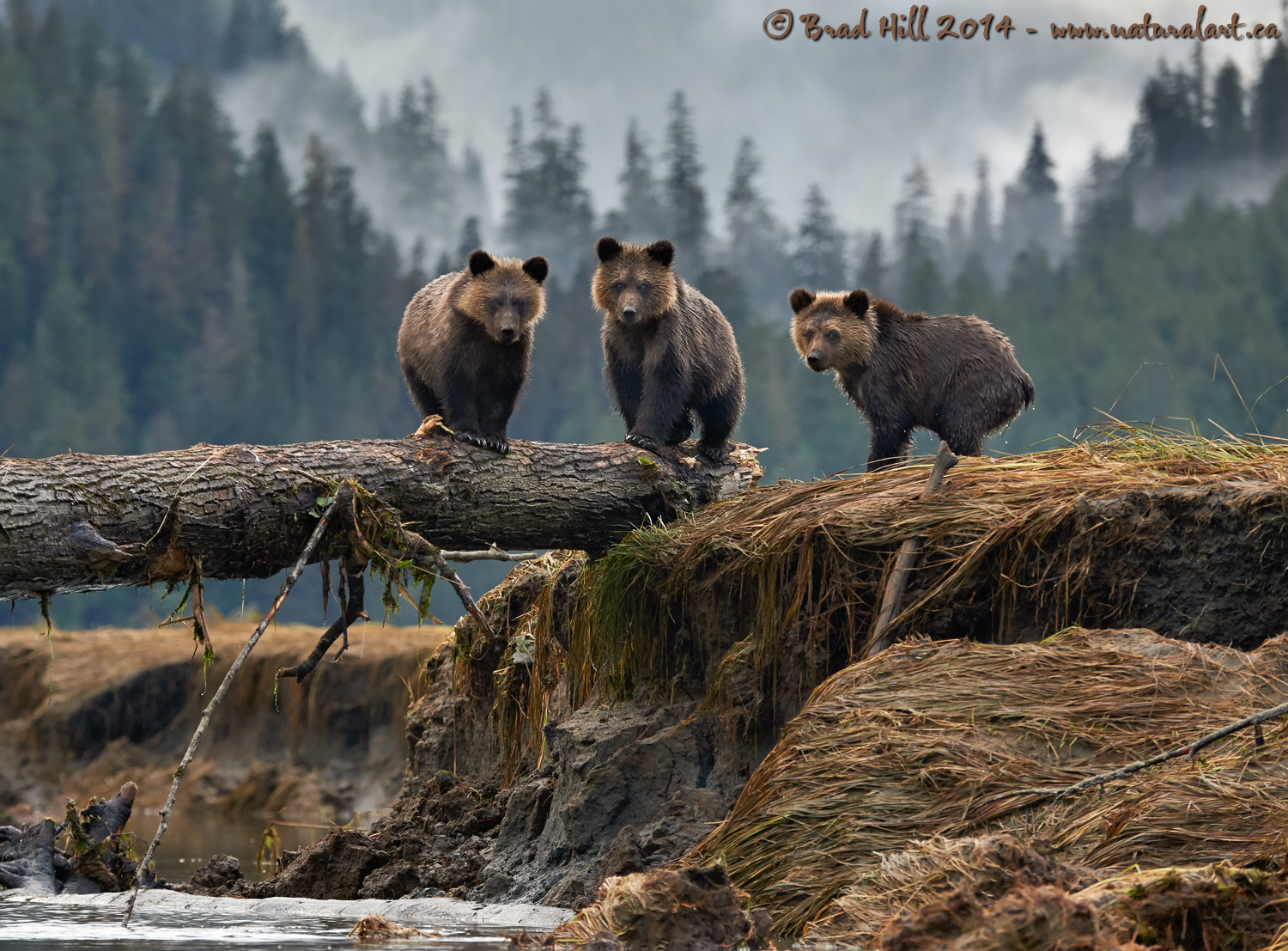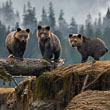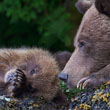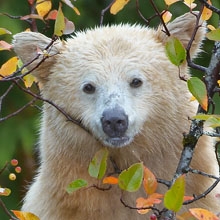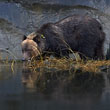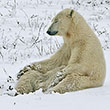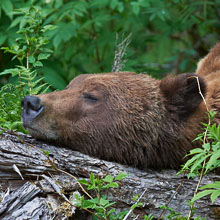Availability: Undetermined - Enquiries?
In the Field
The Cute Trio. Great Bear Rainforest (northern BC coast), BC, Canada. October 4, 2014.
I don't know of anyone who doesn't find young animals cute. Indeed, some argue that the factors that help to define "cute" (including disproportionately big eyes and short "near-pug" noses) are part of an evolutionary strategy to reduce aggression against young, vulnerable animals - both from conspecifics as well as from members of other species (and the reality of natural cross-species adoptions is at least consistent with this argument). So...when these three grizzly cubs-of-the-year chose to give us this unforgettable pose in a remote inlet in the Great Bear Rainforest well...it was a wildlife photographers dream come true! I was with a group of photographers at the time (on one of my Into the Great Bear Rainforest photo tours) and it was interesting that evening to compare the different approaches everyone took at the time (and I mean beyond the "crap, mine's out of focus" comments!). I had an 80-400mm lens in my hands at the time and chose to back off (to 260mm) and capture the moment as what I think of as an "enviroscape" where the subjects are shown within enough of the environment in which they live to give the image context (as opposed to an "animalscape" where the subjects are even smaller in the frame and shown within a much broader landscape).
Those who have been with me in the field know that I'm pretty obsessed with Depth-of-Field (DoF) issues when I'm shooting wildlife. I personally consider DoF as the most under-appreciated of the creative elements of wildlife photography (and it's one of the main reasons I shoot with high-speed super-telephotos - such as the 400mm f2.8E VR - a lot of the time...i.e., so that I can maximize the range of apertures and DoF options available to me). To me getting the DoF just right (for any given scene) is a fascinating exercise in problem-solving and optimization of variables. When you start dealing with two or more subjects your soft-drive's (i.e., your brain's) DoF optimization algorithm must shift - and in most cases the primary consideration becomes finding enough DoF to get the critical regions of all your subjects in focus. This can mean that another variable - which is often separating your subjects from the background through choosing the right aperture - has to be compromised. But this was one of those rare multiple-subject scenes where the subjects aligned themselves almost perfectly along the same focal plane (thanks little fuzz dudes!) AND the distance between them and the background was sufficient that I was able to render the subjects AND the background just the way I wanted. It isn't often this happens, especially with 3 hyperactive grizzly cubs! ;-)
For those wanting to see MORE (or larger) cute - here's a 2400 pixel version for your perusual...
• The Cute Trio: Download 2400 pixel image (JPEG: 1.8 MB)
NOTES:
1. This image - in all resolutions - is protected by copyright. I'm fine with personal uses of it (including use as desktop backgrounds or screensavers on your own computer), but unauthorized commercial use of the image is prohibited by law. Thanks in advance for respecting my copyright!
2. Like all wildlife images on this website, the subject is fully wild and completely unconstrained. Besides the potential impact of my presence, nothing has been done to intentionally alter or affect the ongoing behavior of the subject and, of course, there has been no use of any form of bait or other form of wildlife attractants (including vocalizations).
3. This image was captured during one of my two autumn "Into the Great Bear Rainforest" photo tours in October of 2014. Each year I offer trips into two different parts of the Great Bear Rainforest as well as one to photograph aquatic mammals and oceanscapes near the northern tip of Vancouver Island. And, in selected years, I also offer photo tours to locations to capture other highly sought-after subjects, such as various boreal owl species and wildlife of Canada's Arctic. Details about these trips can be found on the Photo Tours page of this website.
4. Alert - Digitally Manipulated Image: This image clearly crosses the line from simple digital correction to digital manipulation. In this particular case there was a stout stick that was running up from the log all the way up to the middle of the cub on the left side's face - and it was removed from the image during post-processing.
It is my policy to clearly identify ANY images on this website that overstep the bounds of digital correction and enter the territory of digital manipulation (see Voice: Commentary: Digital Correction vs. Digital Manipulation).
Behind the Camera
The Cute Trio. Great Bear Rainforest (northern BC coast), BC, Canada. October 4, 2014.
Digital Capture; Compressed RAW (NEF) 14-bit format; ISO 1800.
Nikon D4 paired paired with Nikkor AF-S 80-400mm f4.5-5.6 VR @ 260mm - hand-held from from Zodiac. VR on and in Active mode.
1/320s @ f6.3; -0.3 stop compensation from "recommended" matrix-metered exposure setting.
At the Computer
The Cute Trio. Great Bear Rainforest (northern BC coast), BC, Canada. October 4, 2014.
RAW Conversion to 16-bit TIFF, including first-pass/capture sharpening using Phase One's Capture One Pro 7. Three raw variants (different versions of a single raw capture) processed, differing by a total of 1.0 stops in exposure.
Further digital corrections on resulting 16-bit TIFF files using Adobe's Photoshop CC 2014. Photoshop adjustments included compositing (blending) of the three output files from the raw converter, selective colour desaturation, selective curves (contrast) adjustment, and selective sharpening for web output.
Conservation
The Cute Trio. Great Bear Rainforest (northern BC coast), BC, Canada. October 4, 2014.
Ten percent of the revenue generated by this image will be donated to Raincoast*.
Species Status in Canada**: Special Concern (May 2002).
While Grizzly Bears (Ursus arctos) are not technically listed as "Endangered" in Canada, they have been extirpated from most of their historical range. Grizzly Bears are far more sensitive to intrusion/disturbance in their habitat than are Black Bears and are being increasingly forced into marginal habitat by human encroachment. The Great Bear Rainforest along the central and northern coast of British Columbia is one of the last strongholds of the Grizzly Bear in Canada, and even this population is coming under increasing pressure.
On December 18, 2017 the government of British Columbia banned grizzly hunting across the entire province. This major conservation victory came after decades of tireless work by many dedicated conservationists and ecologists and, most importantly, it reflects the opinion of the vast majority of British Columbians. And, it means that AT LEAST while the current government remains in power grizzlies are finally "safe" in British Columbia.
Now that we've at least temporarily won the battle to save grizzlies in BC, it's time to re-focus our efforts toward protecting ALL of BC's carnivores, including Gray Wolves, Black Bears, Cougars, Wolverines, and more! Simply put, there are no ecological, economic, or ethical arguments supporting the trophy hunting of carnivores.
In a great first step towards ending the hunting of carnivores throughout BC the Raincoast Conservation Foundation has developed a program designed to protect ALL carnivores within the Great Bear Rainforest. Details about this program can be found on this page on Raincoast's website. Check it out and, better yet, make a donation to help Raincoast purchase the remaining commercial hunting tenures in the Great Bear!
*The Raincoast Conservation Society (and Foundation) is an effective and efficient organization that has been fighting for protection of this unique habitat. If you are looking for a meaningful way to contribute to the conservation of this amazing ecosystem, Raincoast will provide maximal "bang" for your conservation dollars.
**as determined by COSEWIC: The Committee on the Status of Endangered Wildlife in Canada












